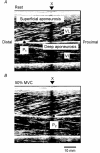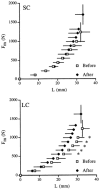Effects of different duration isometric contractions on tendon elasticity in human quadriceps muscles
- PMID: 11600697
- PMCID: PMC2278867
- DOI: 10.1111/j.1469-7793.2001.0649c.xd
Effects of different duration isometric contractions on tendon elasticity in human quadriceps muscles
Abstract
1. The present study aimed to investigate the influence of isometric training protocols with long- and short-duration contractions on the elasticity of human tendon structures in vivo. The elasticity was assessed through in vivo determination of the elongation (L) of the tendons and aponeuroses using ultrasonography, while the subjects performed ramp isometric exercise up to maximum voluntary contraction (MVC). 2. Eight young males completed 12 weeks (4 days per week) of a unilateral isometric training programme on knee extensors, which consisted of two different combinations of contraction and relaxation times at 70 % MVC: one leg was trained using a short-duration protocol (3 sets of 50 repetitions of contraction for 1 s and relaxation for 2 s), and the other leg was trained using a long-duration protocol (4 sets of a combination of contraction for 20 s and relaxation for 1 min). The training volume per session, expressed as the integrated torque, was the same for the two protocols. 3. Both protocols resulted in a significant increase in MVC: 31.8 +/- 17.2 % for the short-duration protocol and 33.9 +/- 14.4 % for the long-duration protocol. Moreover, the training produced significant increases in the muscle volume of the constituents of the quadriceps femoris, with similar relative gains for the two protocols: 7.4 +/- 3.9 % for the short-duration protocol and 7.6 +/- 4.3 % for the long-duration protocol. 4. The short-duration protocol produced no significant change in L values at any of the force production levels. For the long-duration protocol, however, the L values above 550 N were significantly shorter after training. Analysis revealed that the group x test time interaction effect on tendon stiffness was significant. Stiffness increased significantly for the long-duration protocol, but not for the short-duration protocol. 5. The present study demonstrates a greater increase in stiffness of human tendon structures following isometric training using longer duration contractions compared to shorter contractions. This suggests that the changes in the elasticity of the tendon structures after resistance training may be affected by the duration of muscle contraction.
Figures



References
-
- Almeida-Silveira MI, Lambertz D, Perot C, Goubel F. Changes in stiffness induced by hindlimb suspension in rat Achilles tendon. European Journal of Applied Physiology. 2000;81:252–257. - PubMed
-
- Amiel D, Woo SLY, Harwood FL, Akeson WH. The effect of immobilization on collagen turnover in connective tissue: a biochemical-biomechanical correlation. Acta Orthopaedica Scandinavica. 1982;53:325–332. - PubMed
-
- Ball JR, Rich GQ, Wallis EL. Effects of isometric training on vertical jumping. Research Quarterly for Exercise and Sport. 1964;35:231–235. - PubMed
-
- Beger RA. Effects of dynamic and static training on vertical jumping ability. Research Quarterly for Exercise and Sport. 1963;34:419–424.
-
- Behm DG, Sale DG. Intended rather than actual movement velocity determines velocity-specific training response. Journal of Applied Physiology. 1993;74:359–368. - PubMed
MeSH terms
LinkOut - more resources
Full Text Sources

